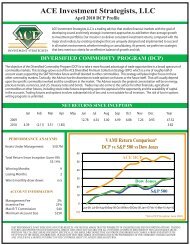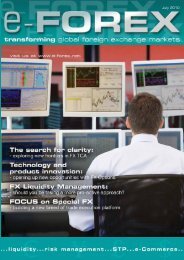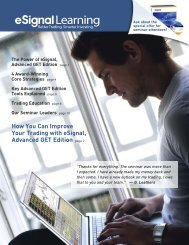Create successful ePaper yourself
Turn your PDF publications into a flip-book with our unique Google optimized e-Paper software.
FEATURES<br />
Sourcing and integration<br />
of historical pricing data<br />
for FX applications<br />
Roger Aitken<br />
The demand for historical FX pricing data shows<br />
little sign of abating, with advances in technology<br />
and algorithmic trading in recent years driving<br />
matters. Roger Aitken canvasses industry opinion<br />
on how this trend is affecting the sourcing and<br />
integration of such data for FX applications.<br />
With trading in the world’s main foreign<br />
exchange markets estimated by a recent<br />
Bank for International Settlements Triennial<br />
survey (December 2007), to be over US$3.2 trillion<br />
(c.€4.5trn) daily, equivalent to 30 times larger than the<br />
NYSE and NASDAQ <strong>com</strong>bined, demand for historical<br />
pricing data would seem assured. This is especially true<br />
given that a tad over US$1trn is accounted by spot FX<br />
transactions alone - largely driven by big institutions<br />
but also fuelled by a rapidly growing online retail FX<br />
trading market. Developing a mechanical FX trading<br />
system requires back testing. And, backtesting for<br />
66 | january 2010 e-FOREX<br />
systematic and algorithmic traders requires plenty of<br />
high quality FX historical price data from which to<br />
build models and evaluate new trading strategies before<br />
they are unleashed into a live environment. As such,<br />
historical price data that includes tick data, raw and<br />
cleansed data, are therefore absolutely critical elements<br />
for many FX trading end users. Generally speaking,<br />
having local copies of data can lead to faster and<br />
improved back testing. Such data can be used to test<br />
MetaTrader 3.0 and MetaTrader 4.0 Expert Advisors,<br />
as well as other proprietary and bespoke platforms for<br />
mechanical FX trading systems.<br />
Increasing demand<br />
Antoine Kohler, Managing Director, ICAP<br />
Information Services in London, <strong>com</strong>menting on the<br />
drivers fuelling increased demand for accessing<br />
historical FX pricing data, says: “Market participants<br />
are be<strong>com</strong>ing increasingly sophisticated. There’s an<br />
element of algo sophistication – in terms of low<br />
latency and accessing pools of liquidity as fast as<br />
possible. That all fuels the demand.”<br />
Whereas participation in the FX markets used to be<br />
limited to banks and other major institutions, the<br />
Internet has extended the range of traders right the<br />
way down to retail investors. Retail FX, or the socalled<br />
‘off-exchange market’ segment, is now estimated<br />
to be 2% of the total FX market with daily trading<br />
volumes of US$60bn-US$80bn (€85bn-€112bn).<br />
A number of FX historical data providers are available<br />
to the institutional and online FX retail trading<br />
<strong>com</strong>munities. Thomson Reuters, ICAP and<br />
Bloomberg between them have a large share of the<br />
market: Reuters Trading for Foreign Exchange<br />
(RTFX), offers a single point of access to global FX<br />
liquidity and is available on Reuters 3000 Xtra and<br />
Reuters Dealing 3000. RTFX, which provides access<br />
to multiple market makers with a single login, is<br />
based on Reuters Electronic Trading technology, used<br />
by over 100 leading FX banks.










